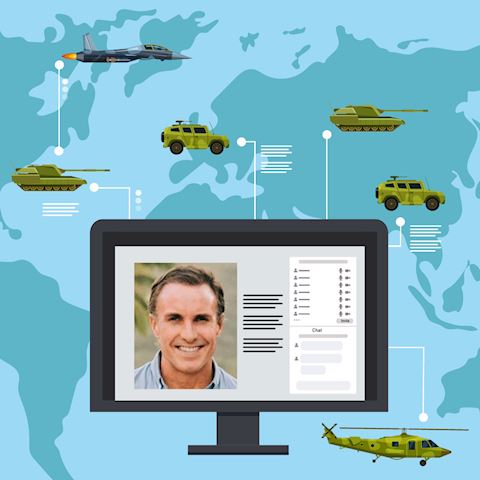
Navigating the rise of technology in construction
In this article we’ll dive into the booming world of smart construction technology, exploring the innovations driving the change and what the future looks like for the industry.

Andrew White, well-respected and specialist international defence editor, gives his views on what's been hot in defence in 2023, and considers how governments are aligning development and procurement programmes, in the context of the Ukraine war, in order to deliver greater efficiency and interoperability.
As we approach the end of the year, the war in Ukraine continues to rage with hostilities likely to extend well into 2024 and perhaps, far beyond.
However, international support of Ukraine’s plight appears unblemished as NATO members and their industrial partners in defence & aerospace continue to support the Ukrainian Armed Forces through the provision of training and material.
As the world’s news outlets and social media platforms continue to publicise the goriest details of the war, government and military leaders around the world are also keenly observing important lessons emerging from this new type of “peer-on-peer” warfare.
Many of these lessons were clearly visible as military, government and industrial leaders convened at the MSPO and DSEI autumn trade shows in Kielce, Poland and London, UK respectively. Both events appeared to have record attendance in terms of exhibitors and visitors.
In Kielce – situated 150 miles from Poland’s border with Ukraine – there was an underlying buzz of urgency as the country’s industrial base considered new ways of supporting their Ukrainian brothers and sisters.
Days later, in London, military and government officials from around the world came together to consider how to counter similar threats, whether they be in Europe or the Indo-Pacific.
Some of the most critical messaging from both events focused on reinforcement of the so-called “magazine depth” of armed forces across NATO as governments continue to donate substantial amounts of ammunition to Ukraine.
At MSPO, the Lockheed Martin and Raytheon Javelin Joint Venture (JJV) signed a memorandum of understanding with Poland’s PGZ which for the first time considered the manufacturing of Javelin components outside the United States. The JJV has already described its intention to increase US manufacturing capacity of Javelin from 2,100 to 3,960 units by 2026.
Similarly, appetite for multi-national defence programmes continued to rise in prominence as governments seek the most efficient and cost-effective means of fielding next-generation technologies as early as possible.
At DSEI, government and industry representatives from Italy, Japan and the UK met publicly for the first time since DSEI Japan in Tokyo six months earlier, to continue discussions regarding the Global Combat Air Programme (GCAP) which aims to deliver a sixth-generation combat air platform by 2035.
Unlike the Eurofighter consortium, which saw Germany, Italy, Spain and the UK duplicating development efforts, GCAP is looking to find ‘best of breed’ solutions from each member nation which can then be replicated across the consortium through technology transfer and local manufacturing.
Discussions remain ongoing regarding workshare agreements and sharing of intellectual property. Interestingly, programme managers are considering the introduction of “24/7” working days with engineers in Europe completing a day’s work before handing over duties to Japanese counterparts ‘overnight’ before resuming work the next day.
Similarly, the European Defence Agency (EDA) is driving ahead with its “FAMOUS” (European Future Highly Mobile Augmented Armoured Systems) all-terrain vehicle programme which currently features a total of nine participating countries.
The project aims to “maximise synergies, standardisation and interoperability capabilities of armoured vehicles to address highly demanding requirements while introducing innovative and promising new technologies and concepts,” according to the EDA. An initial evaluation of vehicle technologies is scheduled to be completed by the end of 2023.
These significant programmes point to an emerging theme in defence & aerospace which is seeing governments aligning development and procurement programmes to optimise economies of scale, interoperability and capacity to field the most modern technologies across the modern battlespace.
European countries in particular are calling for greater levels in cooperation, not only because demand is exceeding supply but also to ensure equipment can be shared between countries in the most appropriate manner.
Speaking at the inaugural SecD-Day conference in Helsinki, Finland in February, Ms Tarja Jaakkola, National Armaments Director of Finland, hailed interoperability as a “fundamental” principle in defence procurement.
“Today, we are talking about ‘inter-changeability’ which means buying the same equipment that others operate as well. We need to keep this in mind in the future to support our partners or to receive support from our partners. We need exactly the same material,” she urged.
Similar sentiments were shared by NATO’s Assistant Secretary General, Defence Investment, Ms. Wendy Gilmour, who added: “We encourage multi-national procurement and projects for economies of scale but we also believe when nations come together to procure capability, it ensures interoperability and also means we get the full gambit of technology and ideas which allow us to fight together better”.
Expect to see more of the same in 2024.
Special thanks to our guest writer, Andrew White.
X: @AndrewJGWhite
Linkedin: https://www.linkedin.com/in/andrew-white-8b8a8049/



In this article we’ll dive into the booming world of smart construction technology, exploring the innovations driving the change and what the future looks like for the industry.

Learn how to use presentation opportunities as an effective lead-generation tool in your trade show activity.

Great marketing success comes from keeping your communications focused, engaging and simple to ‘get’ - but that isn’t always so simple to achieve.

With multiple types of technologies being considered, we bring you a snapshot of alternative fuels and review the most prominent pros and cons for each one.